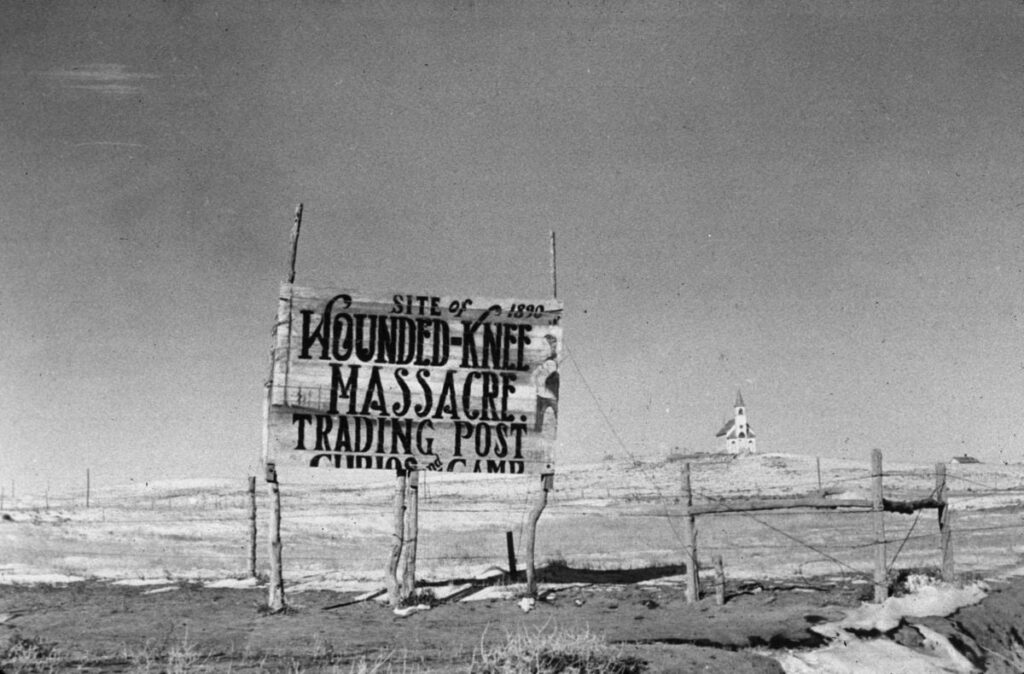Dating from 1940, this photograph depicts a sign at the site of the Wounded Knee Massacre, South Dakota, where 250 American Indians were killed in 1890.
Photo by John Vachon / Library Of Congress / Getty Images
As initial reports of a mass murder of Lakota Native Americans on December 29, 1890, trickled across the nation, newspapers were quick to place the blame on the Lakota. “Indian treachery once more made manifest,” the headline in the Lincoln, Nebraska, State Journal read. Federal troops had killed between 150 and 300 people in southwestern South Dakota in an incident now known as the Massacre at Wounded Knee.
It made sensational news—what one paper called “exciting scenes.”
But these breathless accounts only told the story of the immediate events that led to the massacre. Deeper forces were at play, and a larger context of wars between Plains Indians and the encroaching U.S. government charged the events of December 29.
Created in the aftermath of the Civil War, the Seventh Cavalry regularly engaged in violent clashes with Native Americans. The frontier regiment was known for its infamous defeat at the Battle of Little Bighorn under George Custer 14 years prior. Now, Sitting Bull, the Hunkpapa Lakota warrior who had roused his people at Little Bighorn, had been murdered by federal Indian police.
The regiment was tasked with intercepting, disarming and escorting the Miniconjou, a subdivision of the Lakota, along Wounded Knee Creek on December 28. The Miniconjou had long resisted the compromises of reservation life. But after Sitting Bull’s murder a fortnight prior, their chief, Sitanka, or Big Foot, decided to lead about 350 of his people to Pine Ridge to seek protection from Red Cloud, whom historian Dee Brown called “the last of the great chiefs” in Bury My Heart at Wounded Knee: An Indian History of the American West.
Commanded by James W. Forsyth, the troops waited until “bright and early” the next morning to avoid provoking the tribe, the St. Louis Globe-Democrat wrote. With four Hotchkiss machine guns mounted on a bluff overlooking the camp, the troops demanded the tribe forfeit its weapons. The Miniconjou complied. But the troops were unconvinced that the Miniconjou had really given up all their weapons. They searched the camp, shaking out blankets and rifling through tepees.
The troops only found two rifles. One belonged to Black Coyote, a deaf member of the tribe who either didn’t understand the orders or didn’t want to comply. By some accounts, he fired first. By others, a soldier tried to grab his gun and it went off. Either way, a shot rang out and the massacre began.
“In the first seconds of violence,” Brown wrote, “the firing of carbines was deafening, filling the air with powder smoke.” Sitanka died early on. Then, soldiers fired the Hotchkiss guns.
“We tried to run,” a Miniconjou named Louise Weasel Bear reportedly said afterward. “But they shot us like we were a buffalo.”
Sensationalist white accounts agreed. “The soldiers shot the Indians down wherever found, no quarter being given by anyone,” the Globe-Democrat reported.
“To say that it was a most daring feat, 120 Indians attacking 500 cavalry, expresses the situation but faintly,” the Globe-Democrat continued. “It could only have been insanity which prompted such a deed.”
In an impassioned speech following the massacre, Red Cloud, the leader of the Oglala Lakota whom the Miniconjou wished to ask for protection, offered a fuller explanation.
“I will tell you the reason for the trouble,” he said. “When we first made treaties with the Government, our old life and our old customs were about to end; the game on which we lived was disappearing; the whites were closing around us, and nothing remained for us but to adopt their ways.”
Red Cloud spoke of a saga of promises and hope that his people would one day attain prosperity. But ultimately, the Lakota were left voiceless and misrepresented. “We begged for life and the white men thought we wanted theirs,” Red Cloud said.
As the sun set on December 29, there was little life left at Wounded Knee. The U.S. Army killed 300 Miniconjou, by some estimates, leaving them in the frozen plains and in mass graves, wounds dug into the American earth.


